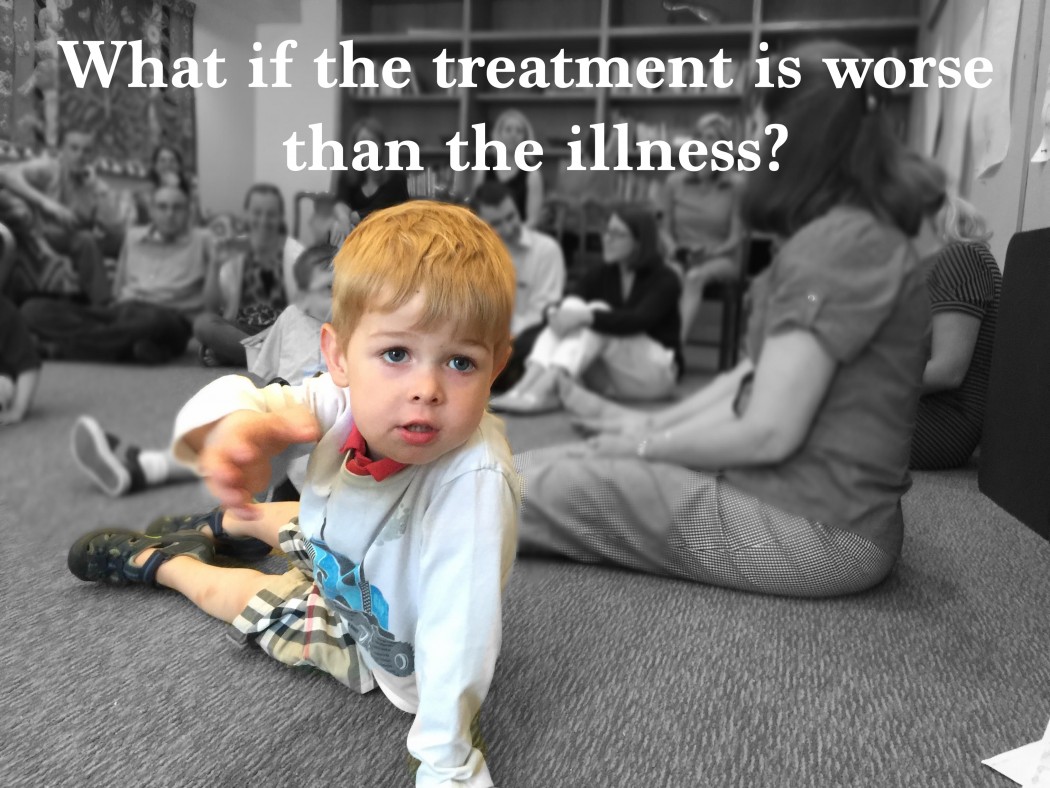Last year our house raged with sickness. From January to May my son had two ear infections, two cases of bronchiolitis, pneumonia, a sinus infection and two stomach bugs.
I picked our pediatrician partly for his conservative reputation when it came to treatment. Last year, there was little room for conservation. Our three year old needed antibiotics. He was doused with various kinds of broad spectrum antibiotics for months, each one treating a new illness.
In April his potty train derailed. He was having such explosive diarrhea that he didn’t even have time to tell me it was happening. He’d come home from school feeling defeated and depressed that he again had a “poop accident.” His teachers would hand me remnants of his clothes wrapped in multiple plastic bags, sometimes including his shoes.
No one could tell me what was going on.
When he spiked a fever in May we went back to the pediatrician’s office, this time in diapers. Our pediatrician wasn’t available, but his sub suggested we take a sample of his feces to see if there was a reason for all the diarrhea. The test showed positive for C-diff.
His gut was ravaged by the over-use of antibiotics.
“C. difficile is an opportunist that can exist in harmony with the other bacteria in our guts; it’s only when that ecosystem is disrupted that C. difficile takes over and becomes deadly. It releases a toxin (which is actually a relative of the toxin sold as Botox, or Clostridium botulinum toxin) that causes a person’s bowels to decay and expand and rupture, and the person dies. Last year in the U.S. alone, C. difficile killed 15,000 people. Most of the cases were precipitated by treatment with an antibiotic.” – The Atlantic
The doctor told me: “We’re seeing more and more cases of c-diff in children. It’s a really nasty thing and one that’s hard to get rid of. It’s a lesson to all of us that sometime the treatment is worse than the illness.”
The problem is that antibiotics are necessary when a child can’t fight an infection on his own. So why is this so much worse today than when we were kids?
The bottom line is antibiotics are pervasive in our lives. It’s not just the doctor writing scripts too readily who’s to blame. It’s the food supply beefing up our meats with medicines to protect the animals from infections that used to be treated with better conditions. Animals living in filth, exposed to dead carcasses and other sick animals would not have been tolerated 50 years ago as a viable product to sell in the supermarket. Today, massive farms are able to circumvent the traditional methods of keeping animals healthy by pumping them with antibiotics, even before they’re sick. We then eat that meat and consume those antibiotics. It turns out even companies like Whole Foods, which said it won’t sell these meats can’t escape the pernicious influence of these antibiotics in our food supply.
” This month, the U.S. Food and Drug Administration quietly released a report that said over the past year, antibiotics sold annually for use in food animals increased to 33,860,000 pounds.
That’s a 22 percent increase since five years prior (which was the first time the amount was even measured). Usage also increased in 2014 alone, despite several prominent food producers and restaurants like Whole Foods and Chipotle swearing off antibiotic-raised animal products. Most of those antibiotics are “medically important,” meaning they are used in humans to treat diseases. But a majority of antibiotics are not absorbed by the animal, just excreted. So even those that are not medically important manage to find their ways into soil and water as they become part of the 18 gallons of manure that every cow produces every day.
Antibiotics in manure that seep into soil have been detected in carrots, lettuce, and green onions. Some antibiotics remain active for months after passing through the animal and are detectable in rivers miles from their use; a study of a river in Colorado found several antibiotics everywhere except for “a pristine site in the mountains before the river had encountered urban or agricultural landscapes.” Antibiotic overuse turned the Hudson River into a breeding ground for drug-resistant bacteria.
Antibiotics do, of course, save many lives in the appropriate medical context. But in animals, antibiotics are rarely given to treat illness. They are given blindly to entire populations to prevent possible infections—which is never indicated medically. Even less medically warranted—actually contrary to the interest of the animal—antibiotics are given as appetite and growth stimulants. In the 1950s, shortly after the advent of modern antibiotics, ranchers noticed that cattle that were treated for infections would put on weight. Because ranchers are paid by the pound, rather than by the number of cattle sold, the idea had appeal. By the 1970s, blanket administration of antibiotics to promote growth became common practice.”
Read the whole story on The Atlantic
My son had a rough fall too, the diarrhea passed, but he had to relearn how to listen to his body and go to the bathroom, after months of surrendering any control. As a mother it was heartbreaking. I was angry and frustrated with what he’d been through. He’s better now, but has to take tons of probiotics to keep from another set-back. After reading this piece in The Atlantic I felt compelled to share his story.
We’ve been so let down by the Food and Drug Administration. Its mission is:
FDA is responsible for protecting the public health by assuring the safety, efficacy and security of human and veterinary drugs, biological products, medical devices, our nation’s food supply, cosmetics, and products that emit radiation.
As far as I can tell the only protection coming from the FDA is the protection of big businesses profiting from the sale of antibiotics and the sale of contaminated food. One could read its mission statement as a list of industries it has failed to protect the public from.
I took my two year old daughter to the doctor yesterday where she was diagnosed with an ear infection. The doctor started to call in a prescription, telling me we should treat the infection since she’s experienced more than 2 weeks of congestion. I did something I didn’t do last year with my son.
“What if we wait? What if we give it a couple more days?”
“She might be up for a few more nights, which would keep you up, but this certainly could clear up on it’s own. It’s up to you.” In fact, the doctor said, ear infections commonly clear up on their own.
Since I have great respect for the doctors at our practice I would never want them to think I presumed to know more than them. I think you should research your choices and pick a doctor you feel is well qualified for what you need. Then you should try, as best as you can to defer to their expertise.
I have learned that the best question to ask, whether for myself or my children is:
“If this were you, what would you do?” Or “If she was your daughter, would you give her the antibiotics or wait?”
You’d be surprised how often the doctor will give you a different answer when the question is posed this way.
Yesterday the answer was: “I’d wait ’till Friday, if it was my daughter.”
So we have the prescription and I’ll fill it if she doesn’t seem better by Friday, but I’m going to wait this time.
We are living in a buyer-beware time. Our children are paying the price. I wish we could all agree that cost is too high.
Please keep yourself informed. Read this story in the Atlantic for more information on the dangers of antibiotics on your gut.






